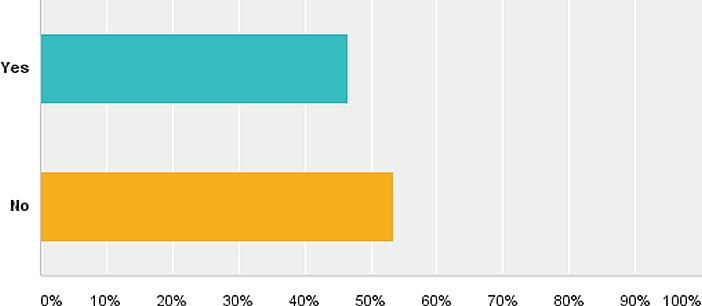The May LANDTHINK Pulse revealed 53.44% of respondents feel that farmers who receive government subsidies should not be allowed to sell their crop to the export market. When the new farm bill was signed into law at the beginning of this year, it brought drastic changes to agricultural subsidies. The farm bill eliminated direct payments and added a subsidy for crop insurance, where farmers get paid in the event of crop failure or if crop prices fall too low. Additionally, the 2014 farm bill funded trade promotions programs, creating more opportunities for farmers and ranchers by tapping into new markets.
Last month, the May Pulse asked: Should a farmer who receives government subsidies be allowed to sell their crop to the export markets?
Once again, the Pulse subject turned out to be a relatively divided issue among our audience. While 53.44% answered “NO”, 46.56% said “YES”, farmers receiving subsidies should be allowed to sell their crops to the export market. The USDA stated that agricultural exports for fiscal year 2014 would reach 149.5 billion, primarily from corn, soybeans and wheat. Undoubtedly, there are strong arguments both for and against farmers selling to the export market. Some might argue that extensive exportation of agricultural crops contribute to public health risk/costs, due to the high ammonia concentration in the air (from fertilizers and manure), and causes land issues, like soil erosion. Those in favor of exportation say it drives growth of the US economy and supports over one million jobs for Americans, according to the USDA. The 2014 farm bill does require farmers that receive subsidies to engage in conservation practices that arise from increased volume of agricultural exports, to fulfill surging demand overseas.
Here are the final results:

- 53.44% said NO, farmers receiving subsidies should not be allowed to sell to the export market
- 46.56% said YES, farmers receiving subsidies should be allowed to sell to the export market
Thank you to everyone who participated and shared the Pulse with friends and connections in the land industry.
LANDTHINK is seeking sponsors for the July LANDTHINK Pulse and months thereafter. Sponsorship of the Pulse is an excellent opportunity for land industry businesses and professionals to receive significant exposure by leveraging our entire network of web and social media sites. Pulse sponsorships are offered on a first come first serve basis and are subject to certain limitations. If your business would be interested in sponsoring next month’s July Pulse question, please contact us soon.
Do you have a suggestion for next month’s Pulse question? Submit your question here and we might choose yours!
Should the government (Federal Bureau of Land Management) be allowed to put solar energy projects on public land? Tell us what you think! Click here to answer the June Pulse question.
This content may not be used or reproduced in any manner whatsoever, in part or in whole, without written permission of LANDTHINK. Use of this content without permission is a violation of federal copyright law. The articles, posts, comments, opinions and information provided by LANDTHINK are for informational and research purposes only and DOES NOT substitute or coincide with the advice of an attorney, accountant, real estate broker or any other licensed real estate professional. LANDTHINK strongly advises visitors and readers to seek their own professional guidance and advice related to buying, investing in or selling real estate.










Hi, I am Linda Peters. Thanks for sharing your details ignore the comment.
The farm bill eliminated direct payments and added a subsidy for crop insurance, where farmers get paid in the event of crop failure or if crop prices fall too low. Additionally, the 2014 farm bill funded trade promotions programs, creating more opportunities for farmers and ranchers by tapping into new markets.the US economy and supports over one million jobs for Americans, according to the USDA. The 2014 farm bill does require farmers that receive subsidies to engage in conservation practices that arise from increased volume of agricultural exports, to fulfill surging demand overseas.Great content. Thanks for sharing insightful information on the rights. Here I am having one basic question.